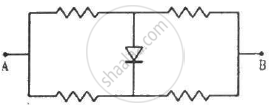Advertisements
Advertisements
प्रश्न
Explain, with the help of a circuit diagram, the working of a photo-diode. Write briefly how it is used to detect the optical signals.
उत्तर
Working of photo diode:
A junction diode made from light sensitive semi-conductor is called a photodiode.

A photodiode is an electrical device used to detect and convert light into an energy signal through the use of a photo detector. It is a pn-junction whose function is controlled by the light allowed to fall on it. Suppose, the wavelength is such that the energy of a photon, hc/λ, is sufficient to break a valance bond. When such light falls on the junction, new hole-electron pairs are created. The number of charge carriers increases and hence the conductivity of the junction increases. If the junction is connected in some circuit, the current in the circuit is controlled by the intensity of the incident light.
APPEARS IN
संबंधित प्रश्न
Explain briefly with the help of necessary diagrams, the reverse biasing of a p-n junction diode. Also draw characteristic curves.
How is a zener diode fabricated so as to make it a special purpose diode? Draw I-V characteristics of zener diode and explain the significance of breakdown voltage.
Explain briefly, with the help of a circuit diagram, how a p-n junction diode works as a half wave rectifier.
If the two ends of a p-n junction are joined by a wire,
The diffusion current in a p-n junction is
Diffusion current in a p-n junction is greater than the drift current in magnitude
Two identical p-n junction may be connected in series with a battery in three ways. The potential difference across the two p-n junctions are equal in

The drift current in a p-n junction is 20.0 µA. Estimate the number of electrons crossing a cross section per second in the depletion region.
Each of the resistance shown in figure has a value of 20 Ω. Find the equivalent resistance between A and B. Does it depend on whether the point A or B is at higher potential?

Find the current through the battery in each of the circuits shown in figure.

(Assume that the resistance of each diode is zero in forward bias and is infinity in reverse bias.)
Choose the correct option.
Current through a reverse-biased p-n junction increases abruptly at:
